Redis 3.0源码分析-数据库
Redis服务器将所有数据库都保存在服务器状态redis.h/redisServer结构的db数组中,db数组的每一项都是一个redis.h/redisDb结构。由redisServer结构的成员dbnum属性决定创建多少个数据库。在服务器内部,客户端状态redisClient结构的db属性记录了客户端当前的目标数据库。

数据库键空间
Redis是一个键值对数据库服务器,服务器中的每个数据库都由一个redisDb结构表示,其中,redisDb结构的dict字典保存了数据库中的所有键值对,我们称这个字典为键空间(key space)。键空间的键也就是数据库的键,每个键都是一个字符串对象。键空间的值也就是数据库的值,每个值可以是字符串对象、列表对象、哈希表对象、集合对象和有序集合对象中的任意一种Redis对象。
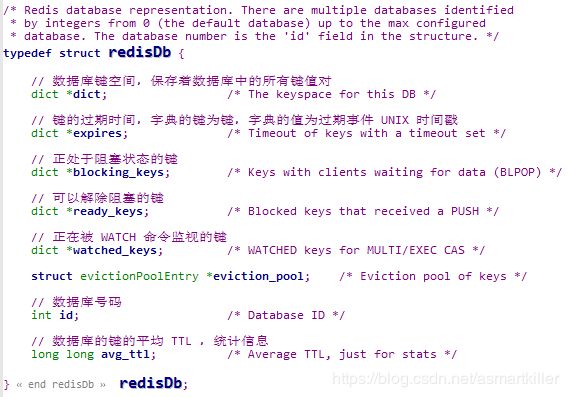
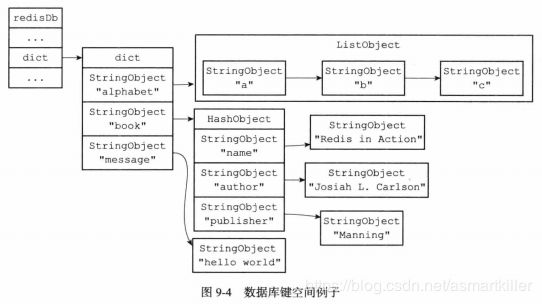
数据库操作相关函数声明在redis.h中,实现在db.c中
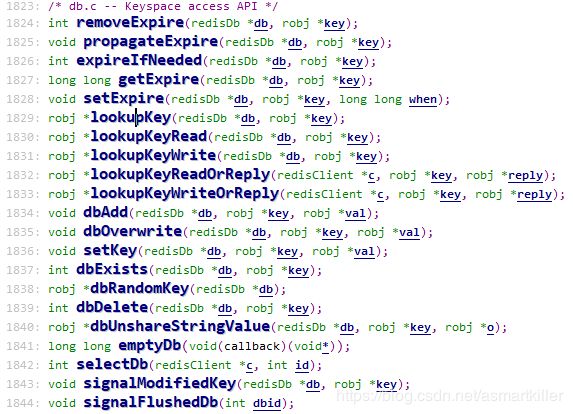
以其中的查找函数lookupKey为例,也是直接使用dict中的查找函数dictFind来查找键空间,判断节点是否存在,存在就取出值,并更新键lru的值。
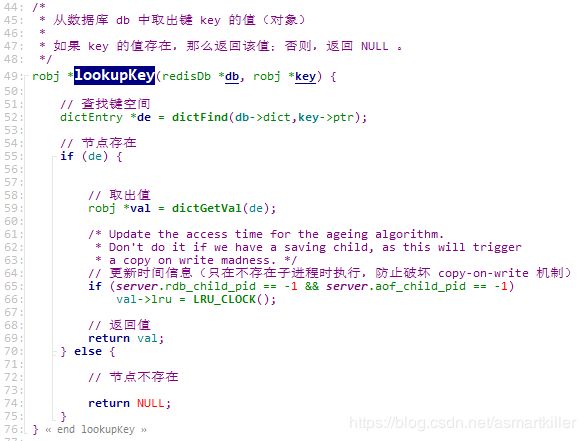
设置键的生存时间或过期时间
redisDb结构的expires字典保存了数据库中所有键的过期时间,我们称这个字典为过期字典:过期字典的键是一个指针,这个指针指向键空间中的某个键对象(也即是某个数据库键)。过期字典的值是一个long long类型的整数,这个整数保存了键所指向的数据库键的过期时间-一个毫秒精度的UNIX时间戳。在实际中,键空间的键和过期字典的键都指向同一个键对象,所以不会出现任何重复对象,也不会浪费任何空间。
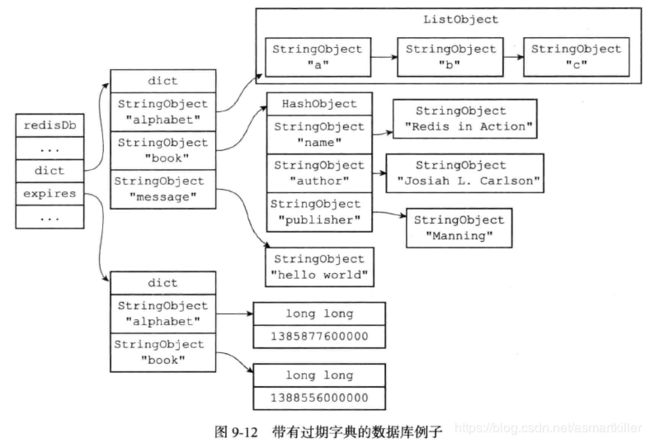
声明在redis.h中,定义在db.c文件中
int removeExpire(redisDb *db, robj *key);
void propagateExpire(redisDb *db, robj *key);
int expireIfNeeded(redisDb *db, robj *key);
long long getExpire(redisDb *db, robj *key);
void setExpire(redisDb *db, robj *key, long long when);


从宏定义dictSetSignedIntegerVal可以看出其中的时间存储于哈希节点使用的dictEntry结构中的union结构中,union结构有三个成员:void* val、uint64_t u64、int64_t s64。u64和s64可用于保存时间值。
过期键删除策略
- 惰性删除:放任键过期不管,但是每次从键空间中获取键时,都检查取得的键是否过期,如果过期的话,就删除该键;如果没有过期,就返回该键。
- 定时删除:在设置键的过期时间的同时,创建一个定时器(timer),让定时器在键的过期时间来临时,立即执行对键的删除操作。
- 定期删除:每隔一段时间,程序就对数据库进行一次检查,删除里面的过期键。至于要删除多少过期键,以及要检查多少个数据库,则由算法决定。
惰性删除策略对CPU时间来说是最友好的:程序只会在取出键时才对键进行过期检查,这可以保证删除过期键的操作只会在非做不可得情况下进行,并且删除得目标仅限于当前处理的键,这个策略不会在删除其他无关的过期键上花费任何CPU时间。惰性删除策略的缺点是,它对内存是最不友好的:如果一个键已经过期,而这个键又仍然保留在数据库中,那么只要这个过期键不被删除,它所占用的内存就不会释放。在使用惰性删除策略时,如果数据库中有非常多的过期键,而这些过期键又恰好没有被访问到的话,那么它们也许永远也不会被删除(除非用户手动执行FLUSHDB),我们甚至可以将这种情况看作是一种内存泄漏-无用的垃圾数据占用了大量的内存,而服务器却不会自己去释放它们,这对运行状态非常依赖于内存的Redis服务器来说,肯定不是一个好消息。
定时删除策略对内存是最友好的:通过使用定时器,定时删除策略可以保证过期键会尽可能快地被删除,并释放过期键所占用的内存。另一方面,定时删除策略的缺点是,它对CPU时间是最不友好的:在过期键比较多的情况下,删除过期键这一行为可能占用相当一部分CPU时间,在内存不紧张但是CPU时间非常紧张的情况下,将CPU时间用在删除和当前任务无关的过期键上,无疑会对服务器的响应时间和吞吐量造成影响。例如,如果正有大量的命令请求在等待服务器处理,并且服务器当前不缺少内存,那么服务器应该优先将CPU时间用在处理客户端的命令请求上面,而不是用在删除过期键上面。除此之外,创建一个定时器需要用到Redis服务器中的时间事件,而当前时间事件的实现方式-无序链表,查找一个事件的时间复杂度为O(N)-并不能高效地处理大量时间事件。
Redis实际使用的是惰性删除和定期删除两种策略,惰性删除策略是由db.c/expireIfNeeded函数实现,所有读写数据库的Redis命令在执行之前都会调用expireIfNeeded函数对输入键进行检查:如果输入键已过期,那么expireIfNeeded函数将输入键从数据库中删除;如果输入键未过期,那么expireIfNeeded函数不做动作。

声明在redis.h中,定义在db.c中
/*
* 检查 key 是否已经过期,如果是的话,将它从数据库中删除。
*
* 返回 0 表示键没有过期时间,或者键未过期。
*
* 返回 1 表示键已经因为过期而被删除了。
*/
int expireIfNeeded(redisDb *db, robj *key) {
// 取出键的过期时间
mstime_t when = getExpire(db,key);
mstime_t now;
// 没有过期时间
if (when < 0) return 0; /* No expire for this key */
/* Don't expire anything while loading. It will be done later. */
// 如果服务器正在进行载入,那么不进行任何过期检查
if (server.loading) return 0;
/* If we are in the context of a Lua script, we claim that time is
* blocked to when the Lua script started. This way a key can expire
* only the first time it is accessed and not in the middle of the
* script execution, making propagation to slaves / AOF consistent.
* See issue #1525 on Github for more information. */
now = server.lua_caller ? server.lua_time_start : mstime();
/* If we are running in the context of a slave, return ASAP:
* the slave key expiration is controlled by the master that will
* send us synthesized DEL operations for expired keys.
*
* Still we try to return the right information to the caller,
* that is, 0 if we think the key should be still valid, 1 if
* we think the key is expired at this time. */
// 当服务器运行在 replication 模式时
// 附属节点并不主动删除 key
// 它只返回一个逻辑上正确的返回值
// 真正的删除操作要等待主节点发来删除命令时才执行
// 从而保证数据的同步
if (server.masterhost != NULL) return now > when;
// 运行到这里,表示键带有过期时间,并且服务器为主节点
/* Return when this key has not expired */
// 如果未过期,返回 0
if (now <= when) return 0;
/* Delete the key */
server.stat_expiredkeys++;
// 向 AOF 文件和附属节点传播过期信息
propagateExpire(db,key);
// 发送事件通知
notifyKeyspaceEvent(REDIS_NOTIFY_EXPIRED,
"expired",key,db->id);
// 将过期键从数据库中删除
return dbDelete(db,key);
}
定期删除策略的实现由redis.c/activeExpireCycle函数实现,每当redis.c/serverCron函数执行时,activeExpireCycle函数就会被调用,它在规定的时间内,分多次遍历服务器中的各个数据库,从数据库的expires字典中随机检查一部分键的过期时间,并删除其中的过期键。
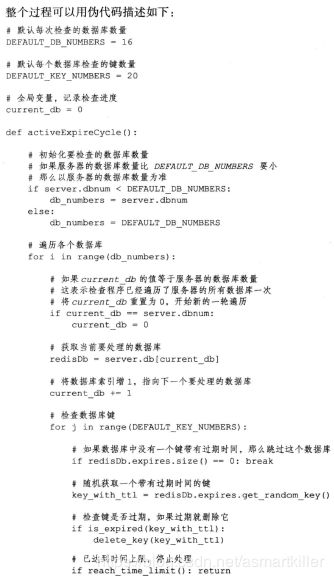
Redis默认每秒进行10次过期扫描,过期扫描不会遍历过期字典中所有的key,而是采用了一种简单的贪心策略,步骤如下:
1.从过期字典中随机选出20个key,2.删除这20个key中已经过期的key,3.如果过期的key的比例超过1/4,那就重复步骤1。为了保证过期扫描不会出现循环过度,导致线程卡死的现象,算法还增加了扫描时间的上限,默认不会超过25ms。
/* Try to expire a few timed out keys. The algorithm used is adaptive and
* will use few CPU cycles if there are few expiring keys, otherwise
* it will get more aggressive to avoid that too much memory is used by
* keys that can be removed from the keyspace.
*
* 函数尝试删除数据库中已经过期的键。
* 当带有过期时间的键比较少时,函数运行得比较保守,
* 如果带有过期时间的键比较多,那么函数会以更积极的方式来删除过期键,
* 从而可能地释放被过期键占用的内存。
*
* No more than REDIS_DBCRON_DBS_PER_CALL databases are tested at every
* iteration.
*
* 每次循环中被测试的数据库数目不会超过 REDIS_DBCRON_DBS_PER_CALL 。
*
* This kind of call is used when Redis detects that timelimit_exit is
* true, so there is more work to do, and we do it more incrementally from
* the beforeSleep() function of the event loop.
*
* 如果 timelimit_exit 为真,那么说明还有更多删除工作要做,
* 那么在 beforeSleep() 函数调用时,程序会再次执行这个函数。
*
* Expire cycle type:
*
* 过期循环的类型:
*
* If type is ACTIVE_EXPIRE_CYCLE_FAST the function will try to run a
* "fast" expire cycle that takes no longer than EXPIRE_FAST_CYCLE_DURATION
* microseconds, and is not repeated again before the same amount of time.
*
* 如果循环的类型为 ACTIVE_EXPIRE_CYCLE_FAST ,
* 那么函数会以“快速过期”模式执行,
* 执行的时间不会长过 EXPIRE_FAST_CYCLE_DURATION 毫秒,
* 并且在 EXPIRE_FAST_CYCLE_DURATION 毫秒之内不会再重新执行。
*
* If type is ACTIVE_EXPIRE_CYCLE_SLOW, that normal expire cycle is
* executed, where the time limit is a percentage of the REDIS_HZ period
* as specified by the REDIS_EXPIRELOOKUPS_TIME_PERC define.
*
* 如果循环的类型为 ACTIVE_EXPIRE_CYCLE_SLOW ,
* 那么函数会以“正常过期”模式执行,
* 函数的执行时限为 REDIS_HS 常量的一个百分比,
* 这个百分比由 REDIS_EXPIRELOOKUPS_TIME_PERC 定义。
*/
void activeExpireCycle(int type) {
/* This function has some global state in order to continue the work
* incrementally across calls. */
// 静态变量,用来累积函数连续执行时的数据
static unsigned int current_db = 0; /* Last DB tested. */
static int timelimit_exit = 0; /* Time limit hit in previous call? */
static long long last_fast_cycle = 0; /* When last fast cycle ran. */
unsigned int j, iteration = 0;
// 默认每次处理的数据库数量
unsigned int dbs_per_call = REDIS_DBCRON_DBS_PER_CALL;
// 函数开始的时间
long long start = ustime(), timelimit;
// 快速模式
if (type == ACTIVE_EXPIRE_CYCLE_FAST) {
/* Don't start a fast cycle if the previous cycle did not exited
* for time limt. Also don't repeat a fast cycle for the same period
* as the fast cycle total duration itself. */
// 如果上次函数没有触发 timelimit_exit ,那么不执行处理
if (!timelimit_exit) return;
// 如果距离上次执行未够一定时间,那么不执行处理
if (start < last_fast_cycle + ACTIVE_EXPIRE_CYCLE_FAST_DURATION*2) return;
// 运行到这里,说明执行快速处理,记录当前时间
last_fast_cycle = start;
}
/* We usually should test REDIS_DBCRON_DBS_PER_CALL per iteration, with
* two exceptions:
*
* 一般情况下,函数只处理 REDIS_DBCRON_DBS_PER_CALL 个数据库,
* 除非:
*
* 1) Don't test more DBs than we have.
* 当前数据库的数量小于 REDIS_DBCRON_DBS_PER_CALL
* 2) If last time we hit the time limit, we want to scan all DBs
* in this iteration, as there is work to do in some DB and we don't want
* expired keys to use memory for too much time.
* 如果上次处理遇到了时间上限,那么这次需要对所有数据库进行扫描,
* 这可以避免过多的过期键占用空间
*/
if (dbs_per_call > server.dbnum || timelimit_exit)
dbs_per_call = server.dbnum;
/* We can use at max ACTIVE_EXPIRE_CYCLE_SLOW_TIME_PERC percentage of CPU time
* per iteration. Since this function gets called with a frequency of
* server.hz times per second, the following is the max amount of
* microseconds we can spend in this function. */
// 函数处理的微秒时间上限
// ACTIVE_EXPIRE_CYCLE_SLOW_TIME_PERC 默认为 25 ,也即是 25 % 的 CPU 时间
timelimit = 1000000*ACTIVE_EXPIRE_CYCLE_SLOW_TIME_PERC/server.hz/100;
timelimit_exit = 0;
if (timelimit <= 0) timelimit = 1;
// 如果是运行在快速模式之下
// 那么最多只能运行 FAST_DURATION 微秒
// 默认值为 1000 (微秒)
if (type == ACTIVE_EXPIRE_CYCLE_FAST)
timelimit = ACTIVE_EXPIRE_CYCLE_FAST_DURATION; /* in microseconds. */
// 遍历数据库
for (j = 0; j < dbs_per_call; j++) {
int expired;
// 指向要处理的数据库
redisDb *db = server.db+(current_db % server.dbnum);
/* Increment the DB now so we are sure if we run out of time
* in the current DB we'll restart from the next. This allows to
* distribute the time evenly across DBs. */
// 为 DB 计数器加一,如果进入 do 循环之后因为超时而跳出
// 那么下次会直接从下个 DB 开始处理
current_db++;
/* Continue to expire if at the end of the cycle more than 25%
* of the keys were expired. */
do {
unsigned long num, slots;
long long now, ttl_sum;
int ttl_samples;
/* If there is nothing to expire try next DB ASAP. */
// 获取数据库中带过期时间的键的数量
// 如果该数量为 0 ,直接跳过这个数据库
if ((num = dictSize(db->expires)) == 0) {
db->avg_ttl = 0;
break;
}
// 获取数据库中键值对的数量
slots = dictSlots(db->expires);
// 当前时间
now = mstime();
/* When there are less than 1% filled slots getting random
* keys is expensive, so stop here waiting for better times...
* The dictionary will be resized asap. */
// 这个数据库的使用率低于 1% ,扫描起来太费力了(大部分都会 MISS)
// 跳过,等待字典收缩程序运行
if (num && slots > DICT_HT_INITIAL_SIZE &&
(num*100/slots < 1)) break;
/* The main collection cycle. Sample random keys among keys
* with an expire set, checking for expired ones.
*
* 样本计数器
*/
// 已处理过期键计数器
expired = 0;
// 键的总 TTL 计数器
ttl_sum = 0;
// 总共处理的键计数器
ttl_samples = 0;
// 每次最多只能检查 LOOKUPS_PER_LOOP 个键
if (num > ACTIVE_EXPIRE_CYCLE_LOOKUPS_PER_LOOP)
num = ACTIVE_EXPIRE_CYCLE_LOOKUPS_PER_LOOP;
// 开始遍历数据库
while (num--) {
dictEntry *de;
long long ttl;
// 从 expires 中随机取出一个带过期时间的键
if ((de = dictGetRandomKey(db->expires)) == NULL) break;
// 计算 TTL
ttl = dictGetSignedIntegerVal(de)-now;
// 如果键已经过期,那么删除它,并将 expired 计数器增一
if (activeExpireCycleTryExpire(db,de,now)) expired++;
if (ttl < 0) ttl = 0;
// 累积键的 TTL
ttl_sum += ttl;
// 累积处理键的个数
ttl_samples++;
}
/* Update the average TTL stats for this database. */
// 为这个数据库更新平均 TTL 统计数据
if (ttl_samples) {
// 计算当前平均值
long long avg_ttl = ttl_sum/ttl_samples;
// 如果这是第一次设置数据库平均 TTL ,那么进行初始化
if (db->avg_ttl == 0) db->avg_ttl = avg_ttl;
/* Smooth the value averaging with the previous one. */
// 取数据库的上次平均 TTL 和今次平均 TTL 的平均值
db->avg_ttl = (db->avg_ttl+avg_ttl)/2;
}
/* We can't block forever here even if there are many keys to
* expire. So after a given amount of milliseconds return to the
* caller waiting for the other active expire cycle. */
// 我们不能用太长时间处理过期键,
// 所以这个函数执行一定时间之后就要返回
// 更新遍历次数
iteration++;
// 每遍历 16 次执行一次
if ((iteration & 0xf) == 0 && /* check once every 16 iterations. */
(ustime()-start) > timelimit)
{
// 如果遍历次数正好是 16 的倍数
// 并且遍历的时间超过了 timelimit
// 那么断开 timelimit_exit
timelimit_exit = 1;
}
// 已经超时了,返回
if (timelimit_exit) return;
/* We don't repeat the cycle if there are less than 25% of keys
* found expired in the current DB. */
// 如果已删除的过期键占当前总数据库带过期时间的键数量的 25 %
// 那么不再遍历
} while (expired > ACTIVE_EXPIRE_CYCLE_LOOKUPS_PER_LOOP/4);
}
}